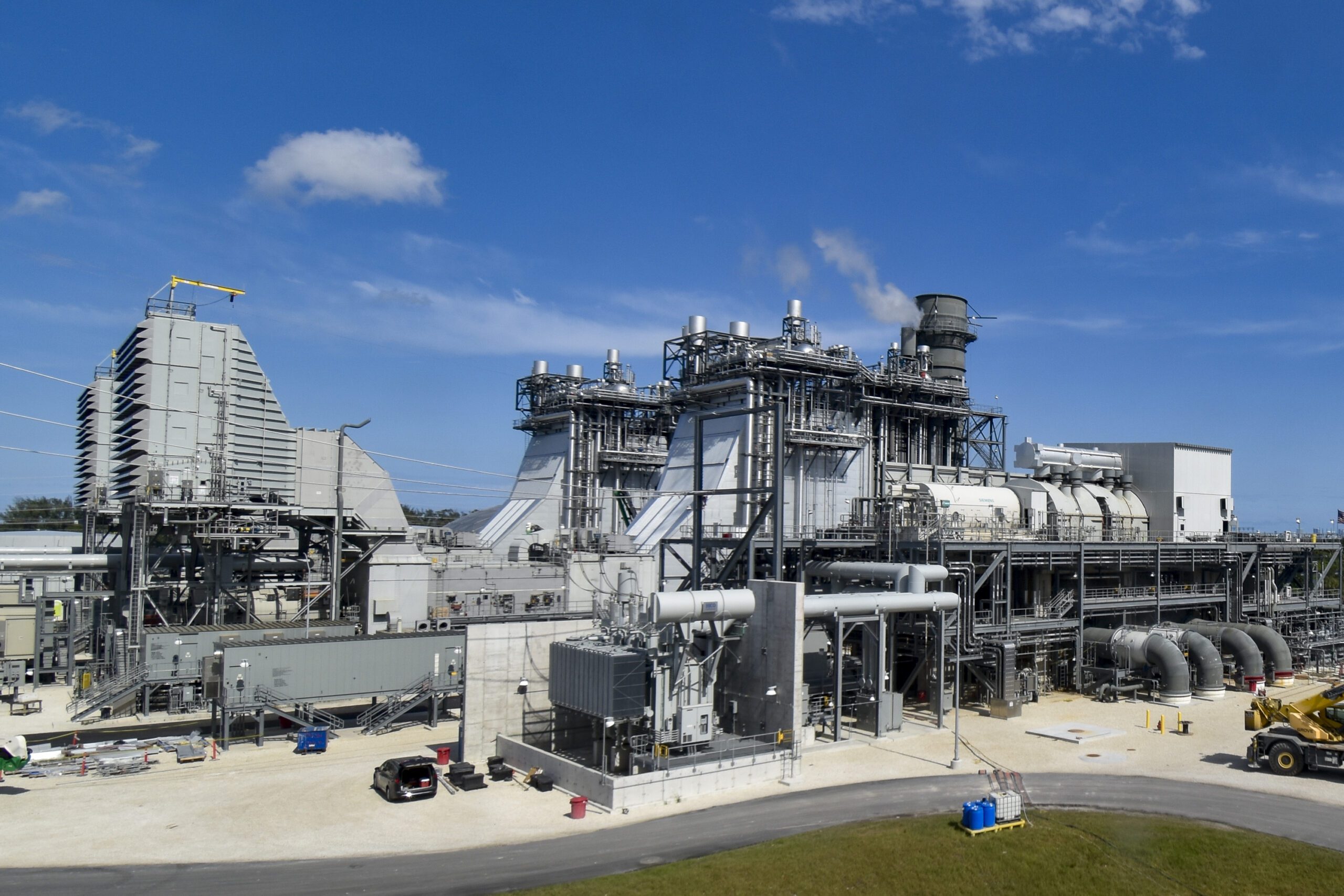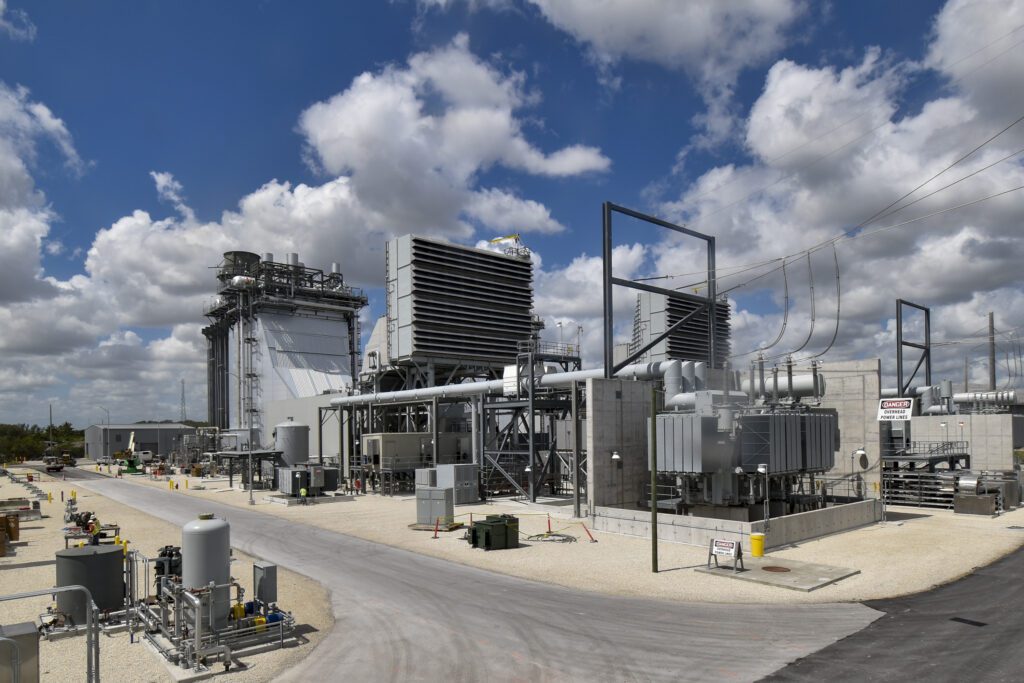GE Debuts First 7HA.03 Gas Turbines at 1.3-GW Plant in Florida
Credit to Author: Sonal Patel| Date: Wed, 08 Jun 2022 14:47:03 +0000

The first two GE 7HA.03 machines—the largest 60-Hz heavy-duty gas turbines in the world and the most efficient in GE’s fleet—are now operational at Florida Power & Light’s (FPL’s) newly inaugurated 1,260-MW Dania Beach Clean Energy Center (DBEC) in Broward County.
FPL officially declared the Dania Beach Clean Energy Center near Fort Lauderdale, Florida, commercially operational on June 1, wrapping up a significant modernization effort at one of its oldest power plant sites. The two 7HA.03 gas turbines, which make up DBEC Unit 7, are slated to help FPL achieve a 70% emissions reduction compared to the previous site and boost reliability and affordability for its customer base in highly populated areas of Miami-Dade and Broward counties.
The milestone is especially significant for American original equipment manufacturer GE, which continues to streamline its gas turbine technology to cater to changing energy markets. DBEC’s inauguration marks the operational start of its 7HA.03—the newest model in its 2014-launched high efficiency air-cooled (HA) gas turbine line—which it only unveiled in October 2019.
The 7HA.03 has a single-cycle net output of 430 MW—a sizable boost compared to its forerunner, the 7HA.02, which is rated at 384 MW, and the first-generation gas turbine in the HA class, the 7HA.01, which is rated at 290 MW. In combined cycle, a 1×1 7HA.03 plant could offer 640 MW. In a 2×1 configuration—as showcased at DBEC—the turbines have an output of 1,282 MW and a net combined-cycle efficiency “of more than” 64%.
It means, as Chris Connor, GE’s 7HA.03 Product Line Director, told POWER, that the 7HA.03 shatters most of GE’s previous combined cycle gas turbine (CCGT) efficiency records—including the 62.22% net efficiency held by the 50-Hz 9HA.01 at EDF’s Bouchain plant and the 63.08% gross efficiency of the 7HA.01 at Chubu Electric’s Nishi Nagoya plant. The new model’s efficiency is comparable to the 9HA.02, GE’s largest 50-Hz machine, which it debuted at Southern Power Generation’s 1.4-GW Track4A plant in southern Malaysia (that project was POWER’s Plant of the Year in 2021).

The ‘Largest, Most Efficient, and Flexible’ 60-Hz Gas Turbine Model
“The GE 7HA.03 gas turbine is the largest, most efficient, and flexible 60-Hz gas turbine currently in operation globally,” Connor noted. That’s because the 7HA.03 introduces—for the first time in a 60 Hz machine—advances in additive manufacturing and breakthroughs achieved with GE’s DLN2.6e combustion technology. GE first debuted the DLN2.6e combustor in the 9HA.02, and it has since been rolled into the 9HA.01, Connor said.
The 7HA.03’s DLN 2.6e combustion system continues to use staged fuel combustion, or axial fuel staging (which is present on all HA gas turbines). It also deploys an advanced premixed, which doubles the fuel flexibility, allowing it to operate on both rich and lean natural gas variants. The combustor’s design also continues to use unibody construction where the liner and transition piece have been combined.

“The combustor that we have in the 7HA.03 is actually at the head end where we have our fuel nozzles and where all the mixing takes place, so it’s almost exactly the same [as with the 9HA.02],” Connor noted. The two models have a lot of similarities. “In fact, a lot of the part numbers are similar, and in some cases the same. We like to take technology and use it in multiple platforms if possible,” he said.
A crucial difference, however, is how the machines address market needs. 9HAs are geared for the 50-Hz markets, which constitute frequencies in large parts of the world (including Europe, Africa, most of Asia, and South America), while 7HAs cater to 60-Hz frequencies, which are typical in most of the Americas, South Korea, and Saudi Arabia.
According to Chris Mastriani, a GE account director who oversaw GE’s relationship with NextEra Energy, FPL’s parent company, FPL—a regulated entity—agreed to be GE’s first customer for the 7HA.03 in 2019, given the rapid rate of significant changes it projected over the next decade. The rapid transition is posing similar dilemmas for utilities all over the world, including as they relate to forecasted natural gas costs; projected costs for new generating units; the efficiency with which generating units convert fuel into power; and costs related to environmental impacts.
In a 10-year site plan submitted to regulators last year, FPL notably underscored the delicate balance it must achieve to provide affordable power while maintaining profitability. Another challenge involves balancing its load and generating capacity, including massive solar additions, particularly in fast-growing metropolitan areas, like Miami-Dade and Broward counties. But the utility is also looking to secure a reliable, flexible source of future supply, given uncertainties about how electric vehicle adoption and other measures could drive up demand, as well as how energy-efficiency measures will affect summer peak load by 2030.
DBEC replaced a 1-GW 4 x 2 CCGT with F-class technology installed in the late 1980s and early 1990s. FPL “needed a power plant that had kind of an energy density or a size perspective that could fit in the existing plant location. It also needed more output than what they had there initially,” Mastriani told POWER. FPL’s strategic emphasis on affordability was also a crucial consideration. Replacing the plant with turbines with a high 60% efficiency “helps provide a lot of value to the ratepayer in terms of fuel cost savings” to the regulated utility, he noted.
GE’s 7HA.03 ultimately satisfies all these requirements, noted Connor. To cater to variability from renewables or demand fluctuations, the turbine can achieve a remarkable 75 MW ramp rate per minute. “We’re talking about a combined 140 MW a minute—you can change the load on those two gas turbines together,” he said. “So if you have a unit running at minimum load, and then you have fluctuation in your renewables output, you can bring load up very quickly with this combined cycle plant. They can turn it down to approximately 20% gas turbine output overnight if they wish—leave it running, not have to go through a start-and-stop cycle—and then ramp up at approximately 140 MW per minute as needed.” That flexibility built into the plant as a proactive measure is a big boost for FPL’s overall push for a balanced network, Connor suggested.
A 50% Hydrogen Capability
But as pivotally, the 7HA.03’s combustion technology ushers in the capability for the 60-Hz markets to burn 50% of hydrogen by volume in natural gas blends “right out of the box,” Connor noted. “A 50% hydrogen capability is one of the biggest differences between this combustor and previous combustors that we’ve had in other F-class or HA-class machines—[which enables] that wider range of fuel flexibility, the high efficiency, the good [nitrogen oxide] emissions, all in one package.”
While the same capability exists in 9HA.02 machines, it hasn’t been a significant driver for customers in Asia yet. FPL is already developing a pilot project that will test using green hydrogen to replace a portion of the natural gas at its 1.6-GW Okeechobee Clean Energy Center in Florida—which uses GE 7HA.02 turbines, Mastriani noted. The pilot, unveiled in February, involves producing 10.8 tons of hydrogen produced per day with a 25-MW Cummins HyLYZER-1000 PEM electrolyzer system at the Cavendish NextGen Hydrogen Hub, which is co-located at the Okeechobee power plant.
A Three-Year Construction Timeframe for a First-of-its-Kind Unit
According to Connor, lessons learned from previous GE installations were pivotal to bringing the first-of-a-kind DBEC unit online on time. GE’s modular-based construction process provided a key benefit, Connor noted. “For all of our 7HAs, we’ve modularized that gas turbine compartment and the gas turbine accessories so that we can put down, basically, building blocks next to the gas turbine that build the accessories and build the compartment all at the same time,” he explained.

“About half the piping that needs to be installed in the field is already pre-assembled in the factory in these modules, and as we put those modules up, that actually constructs the gas turbine compartment. So if you look at an F-class gas turbine compared to an HA, it’s about 25% less labor—or about eight weeks less installation time for a much bigger, much more efficient machine,” he said.
GE’s development of the new model while on a tight timeframe to get it installed within five years of contract signing also leveraged the company’s vast experience and testing capabilities, the GE officials said. The 7HA.03 was validated at GE’s Test Stand 7 in Greenville, South Carolina, one of the world’s largest full-speed, full-load gas turbine test facilities.
GE notably tested the 7HA.03 in Greenville in parallel with the installation of the gas turbines at DBEC, which offered “immediate benefits for the on-site team from the rigorous testing and learning programs,” it said. “GE validated the turbine control system settings and provided the adjustments to system software for improved turbine operability and reliability. In addition, factory testing of GE’s 7HA.03 gas turbine validated that it currently provides the lowest cost conversion of gas to electricity for 60 Hz grids,” it said.
“If we didn’t have Test Stand 7, I think there may not have been the level of trust or confidence in our ability to deliver a machine with the performance and in the time that we did,” said Mastriani. “But leveraging Test Stand 7 and the learnings from there, and giving FPL the confidence that the machine will work and perform as we committed, was a big step for them into signing up for the project, selecting [the 7HA.03] upfront, and then hitting the June 1 [commercial operation] date.”
Asked whether GE is developing further models now that its latest HA model is operational, Connor said GE is constantly investing in improving performance and efficiency. “We’re still doing a couple of tests on the [7HA.03], but we are always looking forward. So we are continuing to invest in both the 60-Hz and the 50-Hz market,” he added. “But we may take a little bit of a breather at the 7HA.03—just for at least a short time.”
—Sonal Patel is a POWER senior associate editor (@sonalcpatel, @POWERmagazine).
The post GE Debuts First 7HA.03 Gas Turbines at 1.3-GW Plant in Florida appeared first on POWER Magazine.